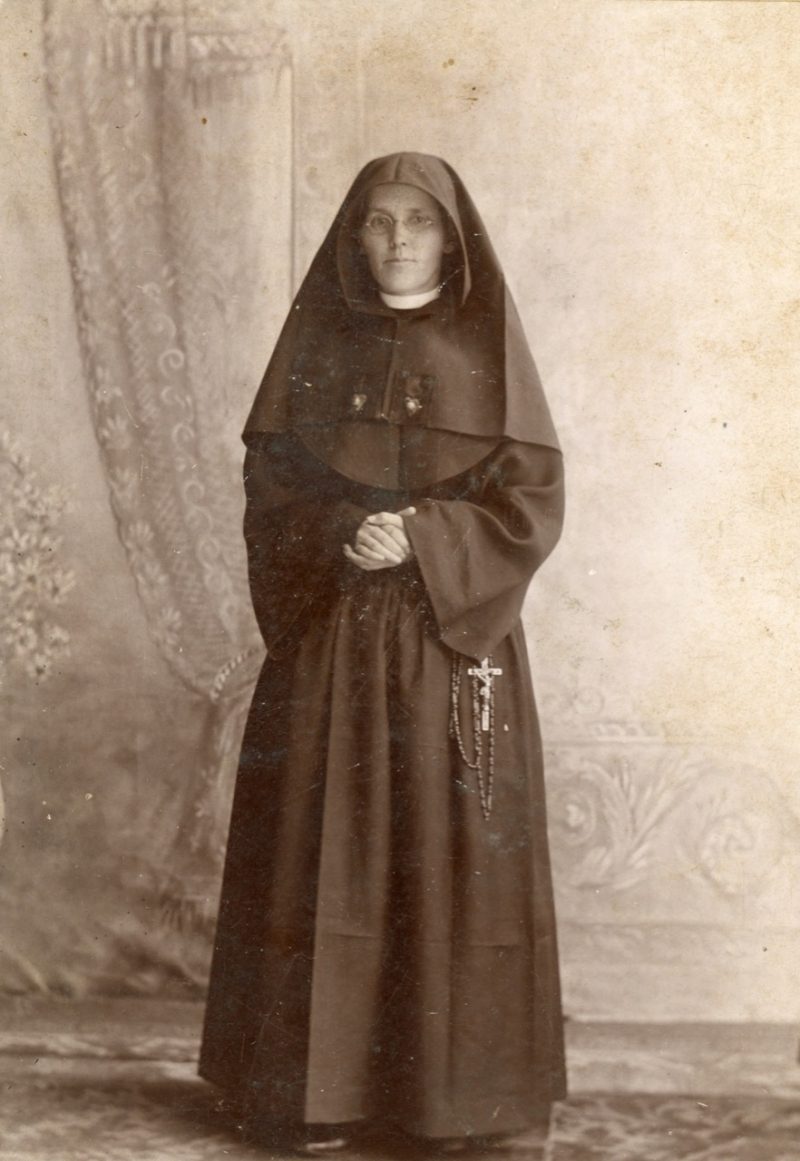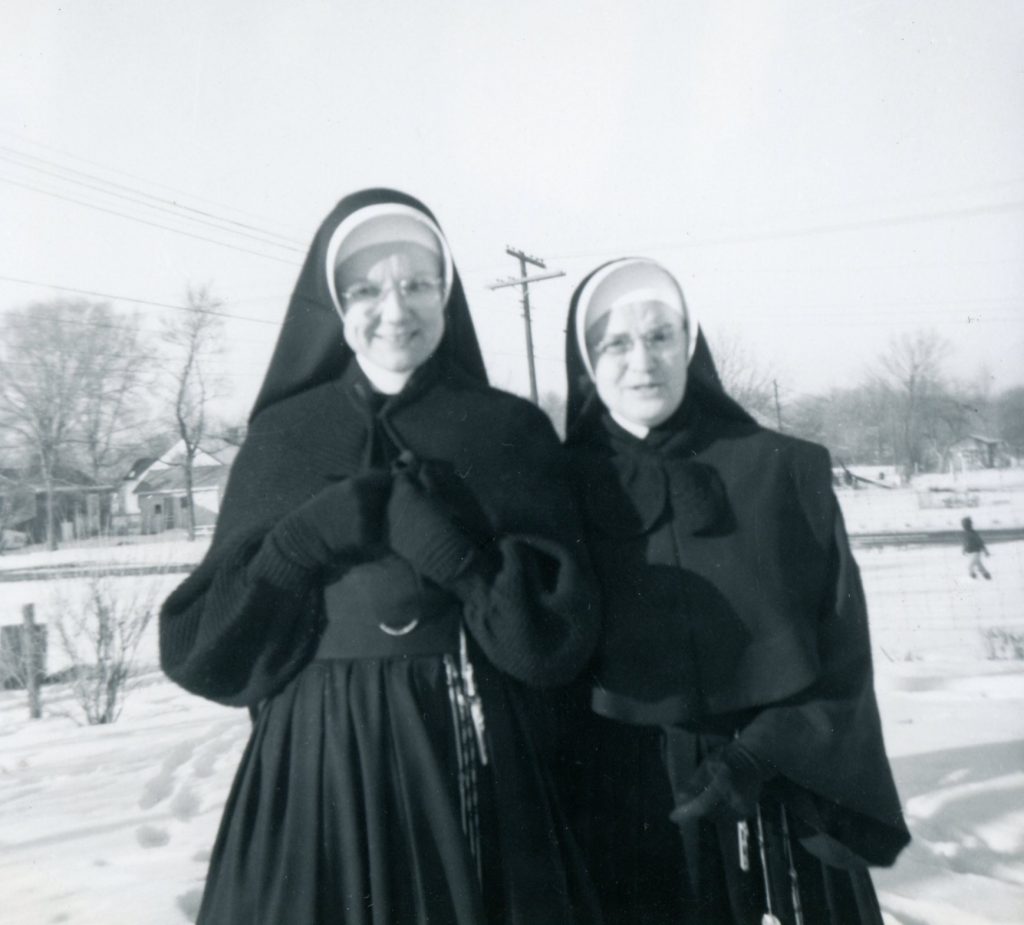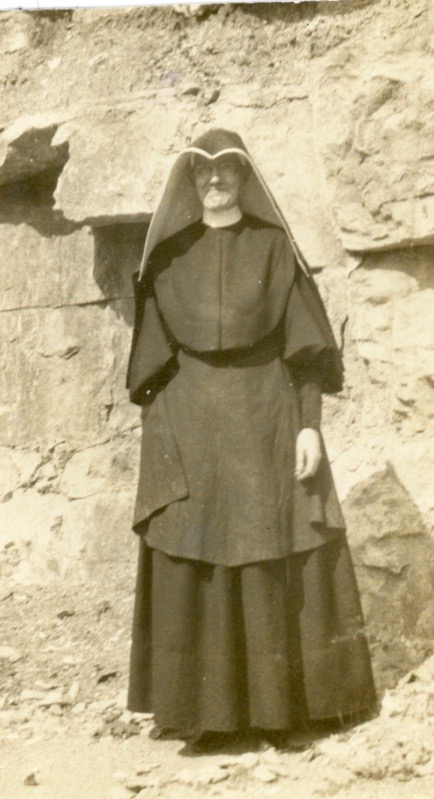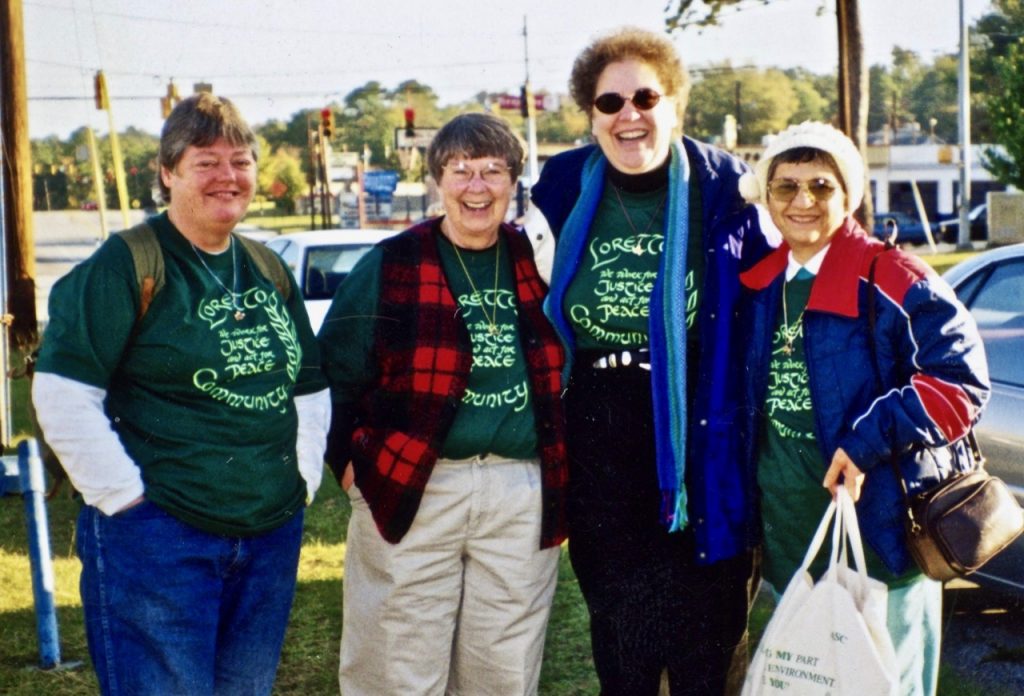Loretto’s Changing Habits
Posted on February 20, 2020, by Loretto Heritage Center
By Susanna Pyatt
Come to the Heritage Center to check out our latest museum update! We’ve added a digital interactive about the history of the habit of the Sisters of Loretto. In the past two centuries since the community was founded, the Sisters have had four major alterations to the style of their habit and veil, plus many smaller changes to their dress. The interactive helps museum visitors explore historic photographs and documents to learn more about the meaningfulness of the Sisters’ habits and the changes to them. Thank you to the Local History Trust Fund, administered by the Kentucky Historical Society, for providing the grant funding to purchase the necessary equipment for this exhibit update!

The earliest Sisters of Loretto likely wore clothing typical for non-Religious women on the Kentucky frontier. Father Charles Nerinckx first set down guidelines for Loretto dress in the Rule he wrote for the community in 1816. “No stuff, but what they make with their own hands, shall be allowed to wear,” was the first rule he set forth. He instructed that the Sisters would wear cotton clothing and go barefoot in the summer, and wear shoes and clothing of yarn or “Country-Cloth” in the winter. A cloak could also be permitted in the cold, with the Superior’s approval. The Sisters’ clothing would be black, and full to hide their figures. The veil would always be worn, at home and “abroad,” and a dark-colored underdress would also always be worn. Underneath this shift was to be worn “half a Scapular of Country Cloth…which may be of 600 linen, never finer.” The coarse linen was a less strict religious observance than the haircloth scapular for which it was a substitute. In keeping with the Sisters’ vows of poverty, only one part of their dress—either the veil or the habit—could be new at the same time.
The most distinctive part of early Loretto dress was the two hearts each Sister embroidered for the front of her veil. The Sacred Heart of Jesus and the sword-pierced heart of Mary represented the founding devotions of Loretto as well as the community’s original motto, “Oh suffering Jesus! Oh sorrowful Mary!” Despite Father Nerinckx’s instructions, the first official habits and veils were not black. The Sisters struggled to find a method of dyeing fabric in which the black color did not wash out of their clothing, so for many years they dyed their habits a more colorfast dark blue. By 1858, they determined to purchase black serge for all their habits, though the first order of this fabric went up in flames when the Motherhouse convent burned.

The habit was meaningful as a symbol of the Sisters’ religious vows and of their identity as Lorettines. Wearing the habit visibly marked them as women religious; the distinctive veil marked them as Sisters of Loretto. Uniformity of the habit helped the community maintain group cohesiveness. Updated Rules specified that all the habits must be of the same fabric, pattern, and make, and to ensure uniformity, all parts of the habit were made in the Motherhouse sewing rooms and sent out to the other Loretto houses. Rules and Custom Books written over the years also specified which rosaries would be worn with the habit, which pocket watches, what material for shawls and how to wear them, etc. Donning the habit every day was itself a part of personal and communal ritual, as each Sister was encouraged to kiss her veil, habit, and girdle—all blessed at the time of her vows—as she put them on in the morning and took them off at night.

Changes to the habit design came in 1909. The view arose that an all-black habit was too intimidating to be worn by a teaching order and too austere to be healthy. The veil was changed to a white-lined veil, heavily starched to maintain an “M” shape. The embroidered hearts were no longer included, and the veil showed the white cap and collar worn with the habit but previously hidden by the veil. These changes were largely accepted by the community, though, as correspondence in the Loretto Archives attests, a few of the clergy with whom the Sisters worked used the matter to make fusses about the Sisters’ adherence to canon law and clerical authority.

The veil was changed again in 1953. The smaller, lighter veil—which used commercially made liners and less fabric—required less time and effort to make and maintain. It also restored Sisters’ range of side vision. With the deep M-veil, the Sisters could not see well enough to drive, and even safely crossing a street could be difficult!
With the changes and challenges of Vatican II in the 1960s, the habit and veil came under consideration once more. In the mid-1960s, Loretto experimented with different, more modernized forms of the habit, including knee-length skirt suits. In 1967, however, the community voted to leave the decision of dress up to the individual. Some Sisters continued to wear either full habits or modified veils for the rest of their lives. Most Sisters, however, chose to no longer wear distinctive religious dress, though many still wear specific rings or other small pieces of jewelry that indicate their identity and commitment as Lorettines and women religious. For these women, leaving the habit behind was a positive change. It allowed them to move through the world doing their work without being bound to the assumptions and idealizations that others often attached to women religious and that many Sisters felt created artificial barriers between them and other people.


I am a graduate of Holy Family High School in Denver, Colo. (1958-1962), where I was taught by these fine Sisters to whom I give credit for a superior education that has served me well through my life. I have many good, fond memories of those four years, the education the Sisters worked to give me and all the students in the school.
God bless you all as you have blessed your students.
Thank you, Mr. Rotella, for your kind comment. May God bless you, too!
I went to Loretto Academy in El Paso, Texas, the late ’50s, early ’60s.
My closest sister and favorite teacher was Sister Adrian. I located her in the ’80s at a rest home for retired sisters in El Paso.
I would like to know if she is still living or if she has passed away.
I always think of her with fondness 🥰💕
Dear Ms. Carrillo,
Thank you for sharing your loving comment about Sister Adrian Corley. While she is no longer living – she died April 18, 2006 – it is so nice to know Sister Adrian made such a wonderful impression on you as she did others.
I was blessed to go to St. Vincent DePaul grade school in Denver. (Class of 1968.)
I was fortunate to have had Lorenttines as some of my teachers
Sister Mary Vivien, Sister Anne Louise, Sister Mary Oscar and Sister Mary Dolorosa and Sister Mary Margaret all left special marks on my heart as well as 6 of my siblings.
Thank you all for sharing your dedication to God and teaching His children with me.
Thank you for sharing your lovely and loving memory of the Sisters, Ms. Mulqueen.
I was born and brought up in this school from 1958 to 1986. My father was the gardener in charge. All the nuns were then called Mothers. All nuns were Europeans except Mother Teresa, also known as Hindi Mother, because she was the only mother who understood Hindi language. I have seen both European students and also students from Bhutan.
There were precious flowers in the school garden. Hariyali Aur Rasta shooting was done in school garden (Mala Singha). Just below our quarters there was a big Rhododendron tree, and it used to blossom in the month of March. Then there was a new building of St. Teresa School. In that place there was a tennis ground. Just above our quarters there was a playground (tennis ground) at the edge of which there was a much fruit-giving pear tree. Among old Mothers were Mother Thekla, Mother Baptista, Sister Branda, Mother Kavin, Mother Rosario. I miss this place very much as my father breathed last in that quarters. “I am the Immaculate Conception” around Mother Mary idol – we used to pray there in the morning before going to school.